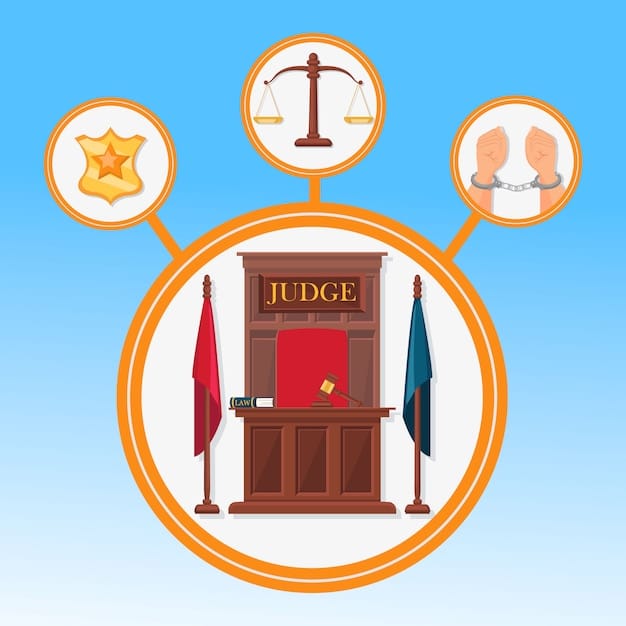Understanding the US Legal System: A Citizen’s Guide to Rights and Processes

The US legal system is a complex framework of federal and state courts interpreting and applying laws, while citizen rights are protected by the Constitution, ensuring fair treatment and due process under the law.
Navigating the US legal system can seem daunting, but understanding its structure and your rights as a citizen is crucial. This guide aims to demystify the system, providing clarity on how it functions and how your rights are protected under the law. We will explore how the US legal system works and what your rights are as a citizen, empowering you with the knowledge to navigate legal situations effectively.
Understanding the Structure of the US Legal System
The United States legal system is a dual system, consisting of both federal and state courts. This structure allows for a balance of power and ensures that different levels of legal issues can be addressed appropriately.Understanding this dual structure is fundamental to grasping how laws are made, interpreted, and enforced across the country.
Federal Courts
Federal courts handle cases involving federal laws, disputes between states, and issues involving the US Constitution. They operate under a three-tiered system, which includes:
- District Courts: These are the trial courts of the federal system, where cases are initially heard and evidence is presented.
- Courts of Appeals: These courts review decisions made by the district courts. There are 13 appellate courts, each covering a specific geographic circuit.
- Supreme Court: The highest court in the nation, the Supreme Court, reviews cases from the Courts of Appeals and state supreme courts. Its decisions set legal precedents that all lower courts must follow.
State Courts
State courts handle the majority of legal cases in the United States, including criminal law, family law, and contract disputes. The structure of state courts can vary, but typically includes:
- Trial Courts: These courts hear cases for the first time, similar to federal district courts.
- Appellate Courts: State appellate courts review decisions made by the trial courts.
- State Supreme Courts: The highest court in each state, which hears appeals from the lower appellate courts.
In summary, the US legal system operates at both the federal and state levels, each with its own structure and jurisdiction. Understanding this dual system is crucial for navigating legal issues and guaranteeing that justice is administered efficiently and fairly.

Sources of Law in the United States
The legal system in the US draws from various sources, including constitutional law, statutory law, administrative law, and common law. Each of these sources plays a distinct role in shaping the legal landscape and governing behavior within the country. Understanding how these sources interact is essential for comprehending the basis of legal arguments and judicial decisions.
Constitutional Law
The US Constitution is the supreme law of the land. It establishes the framework for the federal government and protects fundamental rights and freedoms of individuals. Key aspects of constitutional law include:
- Bill of Rights: The first ten amendments protect individual liberties such as freedom of speech, religion, and the right to bear arms.
- Separation of Powers: The Constitution divides governmental power among the legislative, executive, and judicial branches.
- Federalism: The Constitution divides powers between the federal government and the state governments.
Statutory Law
Statutory laws are laws enacted by legislative bodies, such as Congress at the federal level and state legislatures at the state level. Key characteristics of statutory law include:
- Federal Statutes: Address issues of national concern, such as interstate commerce, taxation, and criminal justice.
- State Statutes: Cover a broad range of issues, including family law, property law, and education.
- Local Ordinances: Enacted by city and county governments, addressing local issues such as zoning and public safety.
Understanding the various levels and types of laws—from the guiding principles of the Constitution to the specific rules set by statutes and administrative codes—is fundamental to navigating the legal landscape effectively. These sources of law work together to provide a framework for order, justice, and the protection of individual rights in the United States.
Your Fundamental Rights as a US Citizen
As a citizen of the United States, you are guaranteed certain fundamental rights under the Constitution and its amendments. These rights protect you from government overreach and ensure fair treatment under the law. Knowledge of these rights is critical for every citizen, allowing you to safeguard your freedom and hold authorities accountable.
Bill of Rights
The Bill of Rights, comprising the first ten amendments to the Constitution, guarantees several essential rights:
- First Amendment: Guarantees freedom of speech, religion, the press, assembly, and the right to petition the government.
- Fourth Amendment: Protects against unreasonable searches and seizures.
- Fifth Amendment: Guarantees due process of law, protection against self-incrimination, and double jeopardy.
- Sixth Amendment: Guarantees the right to a speedy and public trial, the right to an attorney, and the right to confront witnesses.
- Eighth Amendment: Prohibits cruel and unusual punishment.
Other Important Rights
Beyond the Bill of Rights, other constitutional amendments and laws provide additional protections:
- Fourteenth Amendment: Guarantees equal protection under the law and due process at the state level.
- Fifteenth Amendment: Prohibits denying a citizen the right to vote based on race, color, or previous condition of servitude.
- Nineteenth Amendment: Guarantees women the right to vote.
Understanding and exercising these rights is crucial for participating fully in civic life and safeguarding your liberties. As a US citizen, your rights are not merely abstract ideals, but practical tools for navigating legal challenges and holding authorities accountable.
How Laws are Made: The Legislative Process
Understanding how laws are made in the United States provides key insights into the foundations of our legal framework and the representation of citizen interests. The legislative process is a complex series of steps at both the federal and state levels, involving multiple layers of review and debate before a bill can become a law.
Federal Level
At the federal level, the legislative process primarily involves Congress, which consists of the Senate and the House of Representatives. The process typically unfolds as follows:
- Introduction of a Bill: A bill can be introduced in either the House or the Senate.
- Committee Review: The bill is then referred to a relevant committee for review, hearings, and amendments.
- Floor Debate and Vote: If the bill passes the committee, it goes to the full House or Senate for debate and a vote.
- Passage in Both Chambers: The bill must pass in both the House and the Senate.
- Presidential Approval: Once passed by both chambers, the bill is sent to the President, who can sign it into law or veto it.
State Level
The legislative process at the state level is similar to the federal process but varies slightly from state to state. Typically, it involves:
- Introduction of a Bill: A bill is introduced in either the state House or Senate.
- Committee Review: The bill is reviewed by a relevant committee, where it may be amended.
- Floor Debate and Vote: The bill is debated and voted on by the full House or Senate.
- Passage in Both Chambers: The bill must pass in both chambers of the state legislature.
- Gubernatorial Approval: The bill is sent to the Governor, who can sign it into law or veto it.
Participation in the legislative process, whether through voting, contacting representatives, or advocating for causes, is essential. By understanding how laws are made, citizens can more effectively engage with their government.

The Role of the Courts in Interpreting Laws
The judiciary plays a crucial role in the US legal system, serving not just as a place to resolve disputes but also as an interpreter of laws. The courts, at both the federal and state levels, are responsible for clarifying the meaning of statutes, regulations, and constitutional provisions. This interpretative function is essential for ensuring that laws are applied fairly and consistently.
Judicial Review
One of the most significant powers of the judiciary is judicial review, the authority to review laws and executive actions for their constitutionality. This power, established in the landmark case of Marbury v. Madison (1803), allows the courts to:
- Ensure Constitutionality: Determine whether laws or government actions comply with the Constitution.
- Protect Rights: Safeguard individual rights and liberties against government overreach.
- Set Precedents: Establish legal precedents that guide future decisions.
Statutory Interpretation
In addition to judicial review, courts also interpret statutes and regulations to determine their meaning and application. This process involves:
- Plain Meaning: Examining the literal language of the law.
- Legislative Intent: Considering the purpose and intent of the lawmakers when enacting the law.
- Past Precedents: Following previous court decisions that have interpreted similar laws.
The judiciary is crucial for maintaining a balanced legal system and ensuring that laws are applied fairly and consistently. By understanding the role of the courts in interpreting laws, citizens can appreciate the checks and balances that underpin the US government and the importance of an independent judiciary.
Navigating the Legal System: Practical Tips
Navigating the US legal system can be a complex and intimidating process, whether you are dealing with a legal dispute, seeking to understand your rights, or simply trying to comply with the law. This section offers practical tips to help you navigate the legal system effectively and protect your interests.
Know Your Rights
Understanding your rights is the first step in navigating the legal system. Make sure you are familiar with:
- Constitutional Rights: Such as the right to free speech, the right to remain silent, and the right to an attorney.
- Statutory Rights: Laws passed by federal, state, and local governments that protect your interests.
- Contractual Rights: Obligations and protections under agreements you enter into.
Seek Legal Advice
When facing a legal issue, consulting with an attorney is essential. A lawyer can:
- Assess Your Situation: Provide an objective evaluation of your legal standing.
- Explain Your Options: Outline the available courses of action and their potential outcomes.
- Represent You: Advocate for your rights and interests in court or during negotiations.
Document Everything
Keeping detailed records and documentation is crucial for any legal matter. Be sure to:
- Maintain Records: Keep copies of all relevant documents, communications, and evidence.
- Take Notes: Document conversations, meetings, and events with dates, times, and details.
- Organize Your Information: Create a system for organizing your records to facilitate easy retrieval when needed.
By being informed, proactive, and organized, you can navigate the legal system more confidently. Understanding your rights, seeking legal advice when needed, and maintaining thorough documentation are key strategies for protecting your interests and achieving favorable outcomes.
| Key Point | Brief Description |
|---|---|
| ⚖️ Dual Court System | Federal and state courts handle different types of legal matters. |
| 📜 Sources of Law | Laws come from the Constitution, statutes, administrative rules, and common law. |
| 🛡️ Fundamental Rights | Citizens have rights like free speech, due process, and protection against unreasonable searches. |
| 🏛️ Legislative Process | Laws are made through a process involving introduction, committee review, debate, and voting in legislatures. |
Frequently Asked Questions (FAQ)
▼
Federal courts handle cases involving federal laws and disputes between states. State courts handle most other cases, including family law, contract disputes, and state criminal laws.
▼
If arrested, you have the right to remain silent, the right to an attorney, and the right to be informed of the charges against you. These rights are guaranteed by the Fifth and Sixth Amendments.
▼
You can find a lawyer through referrals from friends or family, online directories, or your local bar association. Some organizations also offer free or low-cost legal services for eligible individuals.
▼
Judicial review is the power of the courts to review laws and executive actions for their constitutionality. This power ensures that laws comply with the US Constitution.
▼
The Bill of Rights is the first ten amendments to the US Constitution. It guarantees essential rights and freedoms, such as freedom of speech, religion, and the right to bear arms.
Conclusion
Understanding the US legal system and your rights as a citizen is essential for engaging with your government and protecting your freedoms. By knowing the structure of the courts, the sources of law, and your fundamental rights, you can navigate the legal landscape more effectively and ensure that justice is served.





